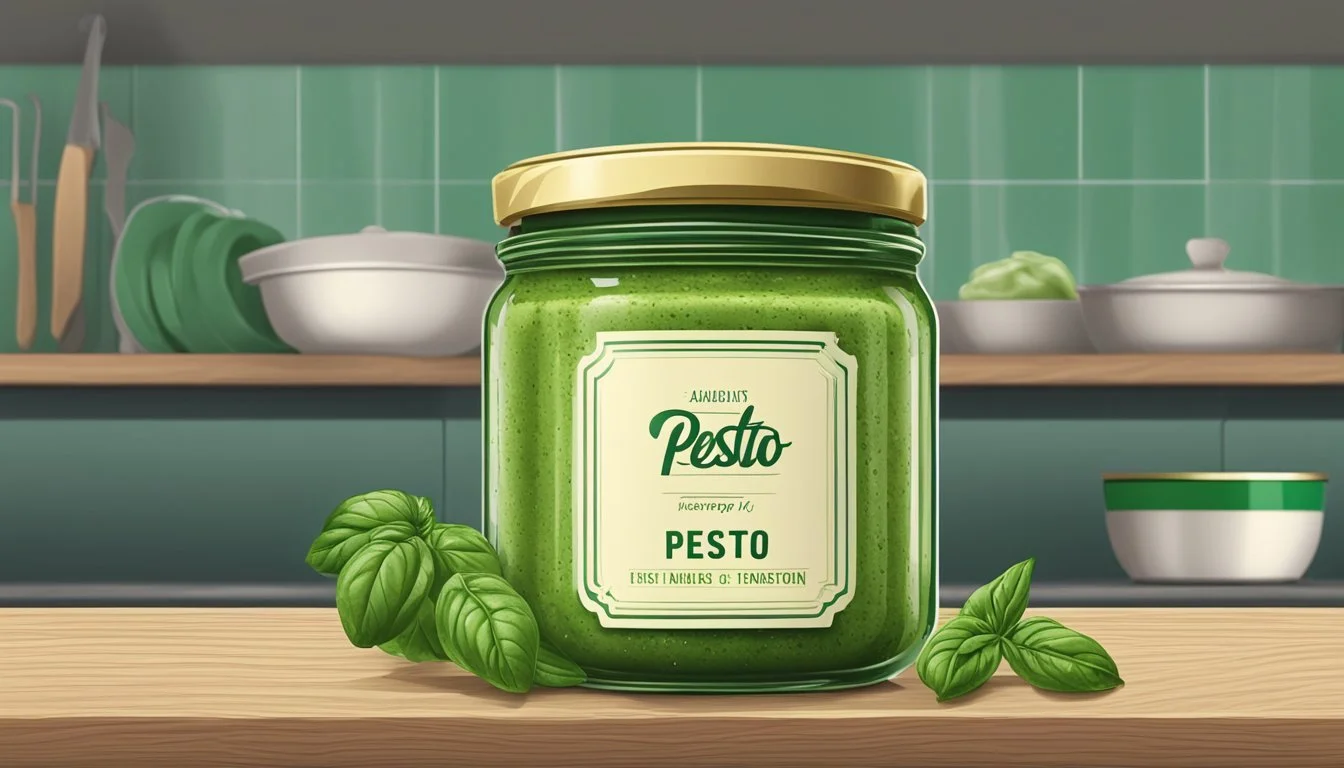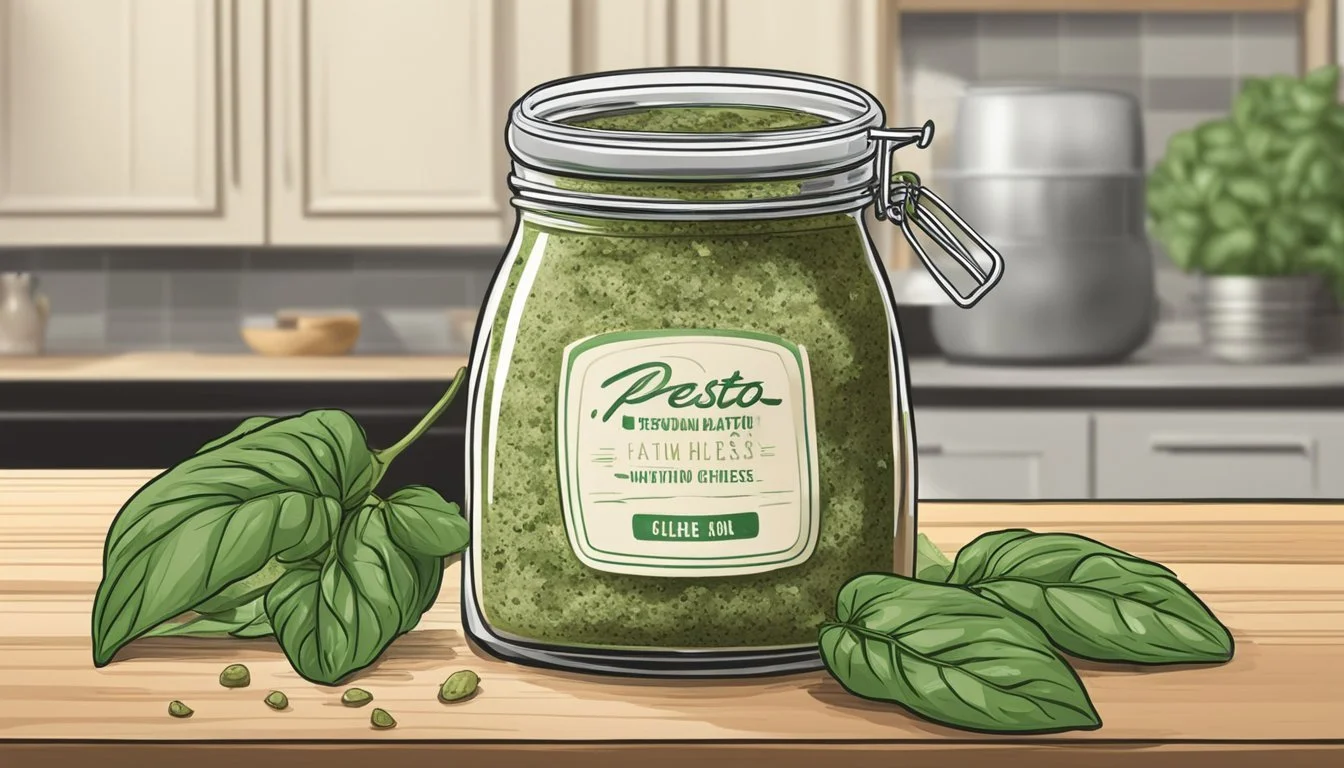How Long Does Pesto Last?
Shelf Life and Storage Tips
The shelf life of pesto is influenced by various factors such as its ingredients, processing methods, and storage conditions. Pesto, a sauce originating from Italy and commonly made with basil, olive oil, pine nuts, Parmesan cheese, and garlic, is a versatile condiment applied to a range of dishes. The longevity of pesto can differ based on whether it is homemade or store-bought, and if it is sealed or has been opened.
Store-bought pesto typically comes with a "best by" date, and unopened it can often remain good for a period beyond this date, especially if it is kept in a pantry. Once opened, however, the pesto's lifespan decreases, and it's generally recommended to consume it within 2 weeks if stored in the refrigerator. The option to freeze pesto presents itself as a reliable method to extend its usability, with a potential shelf life of up to 4 months in the freezer.
Homemade pesto, free from preservatives, tends to have a shorter shelf life. When refrigerated, it usually remains fresh for approximately 1 week. Regardless of the type of pesto or storage method, any changes in color, the presence of mold, or an off smell or taste are indicators that the pesto has spoiled and should not be consumed.
Understanding Pesto
Pesto is a flavorful sauce often used to enhance a variety of dishes. Its longevity is influenced by the ingredients used and the storage method employed.
Types of Pesto
Classic Pesto: The traditional pesto, known as "Pesto alla Genovese," hails from Genoa, Italy. It typically combines fresh basil, pine nuts, Parmesan cheese, olive oil, and garlic, transformed into a cohesive sauce.
Variations: Pesto can vary significantly beyond the classic recipe. Some include alternate herbs, such as parsley or cilantro, and nuts like walnuts or almonds. Each variation brings unique flavors and may affect shelf life differently.
Components Affecting Pesto Longevity
Ingredients: The components of pesto, such as olive oil and acidic ingredients like lemon juice, can act as natural preservatives. However, fresh ingredients like basil and garlic are more perishable, which reduces pesto's shelf life.
Storage:
Refrigeration: Freshly prepared or opened pesto should be stored in the fridge in an airtight container to slow down spoilage.
Freezing: For longer preservation, pesto can be stored in the freezer for up to four months.
Container: An airtight container is crucial to prevent oxidation and contamination, two factors that can lead to spoilage.
Pesto's shelf life is also influenced by the presence or absence of preservatives in store-bought varieties, which tend to last longer than homemade versions.
Storing Pesto
Proper storage extends pesto's shelf life while maintaining its flavor and freshness. Both homemade and store-bought varieties benefit from correct storage practices, which involve refrigeration or freezing and the use of appropriate containers.
Refrigerated versus Pantry Storage
Refrigerated Pesto:
Unopened Store-Bought Pesto: The refrigerator will keep unopened store-bought pesto fresh for 6 months past the "best by" date.
Opened Store-Bought Pesto: Once opened, store in the refrigerator and use within 2 weeks.
Homemade Pesto: Should be consumed within 7 days when stored in the fridge.
Pantry Storage:
Unopened Store-Bought Pesto: Can be stored unrefrigerated in the pantry up to 3 months past the "best by" date.
Homemade Pesto: Not recommended for pantry storage due to absence of preservatives.
Freezing Pesto
Store-Bought and Homemade Pesto: Both can be frozen for up to 4 months. For convenience, freeze in small portions using:
Ice cube trays for individual servings.
Sealable freezer bags or containers with as little air as possible.
Once frozen, transfer the pesto cubes into a sealable bag or container to prevent freezer burn and odor absorption.
Container Selection
Airtight Containers: Use these to store pesto in both the refrigerator and freezer to:
Preserve freshness.
Prevent contamination.
Minimize exposure to air which can result in oxidation and flavor loss.
Lid Integrity: Ensure the container lid fits securely. In the freezer, a tight seal also protects against freezer burn. Jars with screw-top lids or plastic containers with snap-on lids are ideal.
Shelf Life of Pesto
The longevity of pesto varies significantly based on whether it is store-bought or homemade, and whether it has been opened. Understanding its shelf life is essential for maintaining its freshness and flavor.
Unopened Pesto Longevity
Store-bought Pestoo:
Pantry: Typically remains good for up to 3 months past the "best by" date.
Fridge: Can be extended to 6 months past the "best by" date.
Homemade Pesto:
Not applicable as homemade pesto should not be stored unrefrigerated.
Opened Pesto Longevity
Store-bought Pesto:
Fridge: Once opened, it's best to consume within 2 weeks; some varieties may last up to 4 months if frozen.
Homemade Pesto:
Fridge: Advisable to use within 7 days.
Freezer: Properly stored homemade pesto can last for about 4 months.
Identifying Spoiled Pesto
It is essential to recognize the signs of spoilage in pesto to ensure it is safe for consumption. Spoiled pesto will exhibit distinct changes in color, scent, and texture.
Visual and Olfactory Indicators
The first step in identifying spoiled pesto is to examine its color. Fresh pesto typically has a vibrant green hue due to the basil leaves. A change in color, such as browning or darkening, often indicates oxidation or spoilage. Mold growth is another clear sign of decay; if mold, which can appear in various colors, is present either on the surface or inside the container, the pesto is unsafe and should be discarded.
The smell of pesto is another strong indicator of its condition. Fresh pesto has a herby and garlic fragrance. Any odor that is sour, rancid, or generally off-putting suggests that the pesto is no longer safe to use.
Taste and Texture Changes
While it is not recommended to taste suspect pesto, the pesto's flavor can denote spoilage if it tastes unusually sour or rancid. In terms of texture, fresh pesto is smooth with a slightly grainy presence from the pine nuts. Spoiled pesto may become overly watery or unusually thick, signifying that it is best to err on the side of caution and discard the product.
Utilization Tips
Pesto, with its rich basil flavor, serves as a versatile ingredient in Italian cuisine. It's most commonly used to enhance the taste of a dish, infusing it with the freshness of herbs and the tanginess of Parmesan cheese. When it comes to incorporating pesto into meals, the options are plentiful and can transcend traditional uses.
Culinary Uses for Pesto
Pesto's vibrant and herbaceous character makes it ideal for a variety of culinary applications. It's traditionally paired with pasta, adding depth and freshness to the dish, often taking the place of other Italian sauces such as marinara. Chefs may also incorporate pesto into other types of sauces to create a nuanced flavor profile, or use it as a base in the preparation of savory pastries and bread.
Here are some specific culinary uses for pesto:
Stirring into hot pasta dishes (What wine goes well with pasta dishes?) for an herbal brightness
Layering in lasagna as an alternative to classic tomato-based sauces (What wine goes well with tomato-based sauces?)
Swirling into creamy soups as a garnish
Blending with mayonnaise or yogurt to create a unique dressing for salads
Spreading on pizza dough before adding other toppings
Pesto as a Condiment
Apart from its primary role in pasta dishes, pesto sauce functions beautifully as a condiment. Its bold and concentrated flavor can elevate the taste of sandwiches and wraps, providing a flavorful alternative to traditional condiments. Pesto's role as a condiment extends to being a companion for grilled foods, where a dollop can impart an Italian zest to meats and vegetables.
Consider the following condiment uses for pesto:
Dollop on top of grilled chicken or fish to enhance the overall flavor
Spread on sandwich bread as a flavorful complement to deli meats and cheeses
Mix with softened butter to create a pesto-infused spread for artisan breads
Drizzle as a finishing sauce over roasted or grilled vegetables (What wine goes well with grilled vegetables?) for an extra burst of flavor
Health and Safety Considerations
When storing pesto, one must be mindful of food safety to prevent health risks. Maintaining proper hygiene and understanding the risk of bacterial growth are essential in ensuring the pesto remains safe to consume.
Risk of Bacterial Growth
Pesto is a perishable food item prone to organic growth due to the presence of fresh ingredients such as basil, garlic, and pine nuts. Bacterial growth, particularly from Pathogenic bacteria like Salmonella and E. coli, can occur if pesto is not stored correctly or kept beyond the recommended time frame. In the refrigerator, opened pesto can last up to 2 weeks. Once this period lapses, or if any signs of spoilage like mold or an off smell are detected, the pesto should be discarded to avoid foodborne illness.
Hygiene Practices
Good kitchen hygiene practices are crucial in preventing contamination of pesto. One should always:
Wash their hands thoroughly before and after handling pesto.
Use clean utensils to avoid cross-contamination.
Keep the pesto in a sealed container to protect it from exposure to bacteria.
Ensure the refrigerator's temperature is set below 40°F (4°C), as the cool environment slows bacterial growth.
By adhering to these hygiene standards, one minimizes health risks and extends the shelf life of pesto.
Homemade Pesto Preparation and Storage
Creating homemade pesto ensures fresh flavor that store-bought alternatives often lack. Proper preparation and storage are key to preserving its vibrant color and robust taste.
Making Fresh Pesto
To make fresh pesto, one requires a food processor or blender. They begin by combining fresh basil leaves, garlic, pine nuts, grated Parmesan cheese, and olive oil. They may pulse and blend the ingredients until reaching a smooth consistency. Incorporating a pinch of salt enhances flavor and acts as a natural preservative.
Extending Homemade Pesto's Freshness
When storing homemade pesto, individuals aim to maintain its freshness for as long as possible. They should transfer the pesto into airtight containers such as mason jars or plastic containers. Adding a thin layer of olive oil on top of the pesto before sealing can act as a protective barrier against oxidation. To preserve the pesto's signature green hue, one might consider incorporating a bit of lemon juice, as its acidity helps prevent browning.
Storage Method Expected Shelf Life Refrigerator Up to 1 week Freezer Up to 4 months
Ensuring the pesto is stored immediately after preparation will help extend its freshness. The freezer option is ideal for long-term storage, while the refrigerator is suitable for more immediate use.





